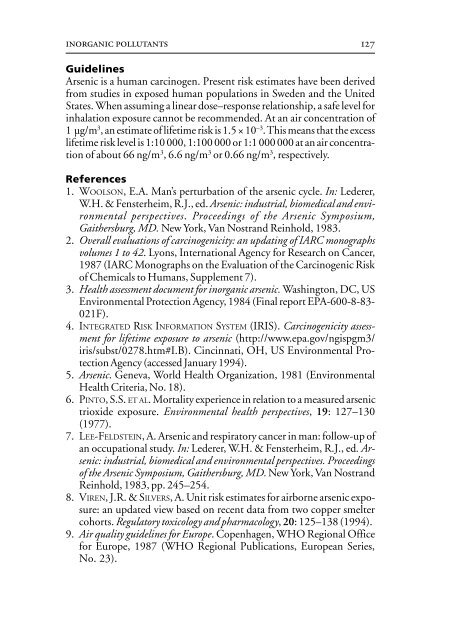Air Quality Guidelines - World Health Organization Regional Office ...
Air Quality Guidelines - World Health Organization Regional Office ...
Air Quality Guidelines - World Health Organization Regional Office ...
Create successful ePaper yourself
Turn your PDF publications into a flip-book with our unique Google optimized e-Paper software.
inorganic pollutants<br />
127<br />
<strong>Guidelines</strong><br />
Arsenic is a human carcinogen. Present risk estimates have been derived<br />
from studies in exposed human populations in Sweden and the United<br />
States. When assuming a linear dose–response relationship, a safe level for<br />
inhalation exposure cannot be recommended. At an air concentration of<br />
1 µg/m 3 , an estimate of lifetime risk is 1.5 × 10 –3 . This means that the excess<br />
lifetime risk level is 1:10 000, 1:100 000 or 1:1 000 000 at an air concentration<br />
of about 66 ng/m 3 , 6.6 ng/m 3 or 0.66 ng/m 3 , respectively.<br />
References<br />
1. WOOLSON, E.A. Man’s perturbation of the arsenic cycle. In: Lederer,<br />
W.H. & Fensterheim, R.J., ed. Arsenic: industrial, biomedical and environmental<br />
perspectives. Proceedings of the Arsenic Symposium,<br />
Gaithersburg, MD. New York, Van Nostrand Reinhold, 1983.<br />
2. Overall evaluations of carcinogenicity: an updating of IARC monographs<br />
volumes 1 to 42. Lyons, International Agency for Research on Cancer,<br />
1987 (IARC Monographs on the Evaluation of the Carcinogenic Risk<br />
of Chemicals to Humans, Supplement 7).<br />
3. <strong>Health</strong> assessment document for inorganic arsenic. Washington, DC, US<br />
Environmental Protection Agency, 1984 (Final report EPA-600-8-83-<br />
021F).<br />
4. INTEGRATED RISK INFORMATION SYSTEM (IRIS). Carcinogenicity assessment<br />
for lifetime exposure to arsenic (http://www.epa.gov/ngispgm3/<br />
iris/subst/0278.htm#I.B). Cincinnati, OH, US Environmental Protection<br />
Agency (accessed January 1994).<br />
5. Arsenic. Geneva, <strong>World</strong> <strong>Health</strong> <strong>Organization</strong>, 1981 (Environmental<br />
<strong>Health</strong> Criteria, No. 18).<br />
6. PINTO, S.S. ET AL. Mortality experience in relation to a measured arsenic<br />
trioxide exposure. Environmental health perspectives, 19: 127–130<br />
(1977).<br />
7. LEE-FELDSTEIN, A. Arsenic and respiratory cancer in man: follow-up of<br />
an occupational study. In: Lederer, W.H. & Fensterheim, R.J., ed. Arsenic:<br />
industrial, biomedical and environmental perspectives. Proceedings<br />
of the Arsenic Symposium, Gaithersburg, MD. New York, Van Nostrand<br />
Reinhold, 1983, pp. 245–254.<br />
8. VIREN, J.R. & SILVERS, A. Unit risk estimates for airborne arsenic exposure:<br />
an updated view based on recent data from two copper smelter<br />
cohorts. Regulatory toxicology and pharmacology, 20: 125–138 (1994).<br />
9. <strong>Air</strong> quality guidelines for Europe. Copenhagen, WHO <strong>Regional</strong> <strong>Office</strong><br />
for Europe, 1987 (WHO <strong>Regional</strong> Publications, European Series,<br />
No. 23).

















